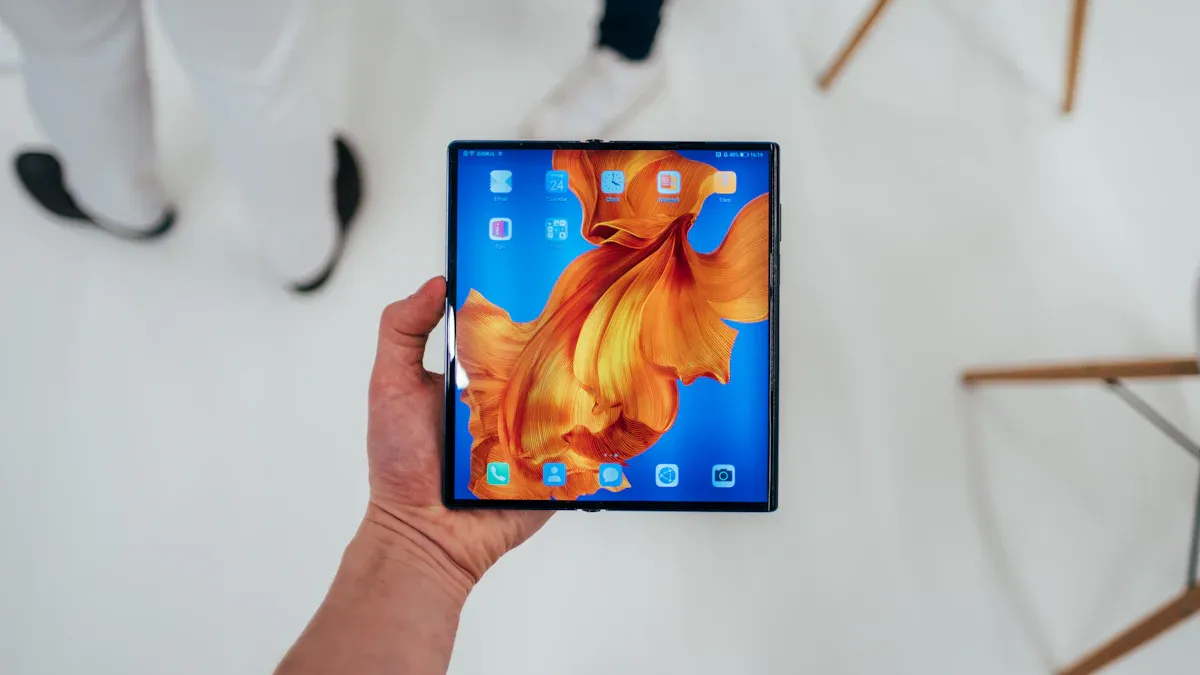
Is Apple losing to Huawei? Recent market data shows Apple’s smartphone market share dropped to 15% in 2024, while Huawei reached 16% with a 37% increase in shipments. Apple still leads in wearables and app revenue, with $123 billion in gross revenue from its App Store in 2025. The question matters to tech fans, investors, and consumers because these numbers could signal a shift in the industry. Vertu once led in luxury phones, but Apple’s current challenges show how quickly leaders can face tough competition.
|
Metric |
Apple (2024) |
Huawei (2024) |
|---|---|---|
|
Market Share |
15% |
16% |
|
YoY Shipments |
-3.1% |
+37% |
Key Takeaways
-
Huawei grows fast by offering new technology and strong local support in China.
-
Apple’s sales drop in China hurts its global market position.
-
Consumers want affordable phones with advanced features like AI and foldable designs.
-
Apple can recover by launching exciting products and adjusting prices.
-
The smartphone market changes quickly, so innovation and local focus matter most.
Is Apple Losing to Huawei?
Market Share
The question “is apple losing to huawei?” has become more important in 2025 as new data shows a shift in the smartphone market. In Q1 2025, Huawei increased its global market share to 19%, while Apple dropped to 15%. This change marks a significant moment for both companies. The table below shows the latest market share numbers:
|
Brand |
Q4 2024 |
Q1 2025 |
|---|---|---|
|
Huawei |
17% |
19% |
|
Apple |
17% |
15% |
In China, the competition is even more intense. Huawei’s smartphone shipments rose by 10% to 12.9 million units in Q1 2025. This growth pushed Huawei’s market share in China to 18%. Apple’s shipments fell by 9% to 9.8 million units, dropping its share to 13.7%. Xiaomi led the Chinese market with an 18.6% share, but Huawei’s rise stands out. Apple now ranks third in China, showing a clear answer to the question: is apple losing to huawei? In Q4 2024, Huawei reclaimed the top smartphone seller position in China with an 18.1% share, while Apple fell to third place after an 18.2% drop in sales. These numbers highlight a real shift in the smartphone market, especially in China.
Globally, Apple still holds strong positions in North America, Japan, and India. The launch of the iPhone 16e helped Apple’s shipments grow by 12% year-over-year in Q1 2025. However, Huawei’s gains in China and the Asia-Pacific region show that the answer to “is apple losing to huawei?” depends on the region. In China, Huawei has become the top smartphone seller, while Apple faces a decline in market share.
Consumer Sentiment
Consumer sentiment plays a big role in the battle between Apple and Huawei. In 2025, surveys show that Apple and Samsung keep strong brand loyalty in the US. However, Apple may be losing some appeal among women. Many consumers now want advanced AI features in their phones. Men and higher-income households show the most interest, but price remains a key factor for everyone. Apple responded by releasing a cheaper iPhone model with AI features. This move aims to answer the question: is apple losing to huawei? by making the iPhone more attractive to price-sensitive buyers.
In China, the story is different. Huawei’s new Mate XT tri-fold phone received almost 5.74 million preorders soon after launch. This high demand comes from both patriotism and a preference for local brands. A recent survey on Weibo found that half of the respondents thought the Mate XT was too expensive, showing that price sensitivity is strong in China. Apple faces other challenges in China, such as delays in rolling out AI features in Chinese, new regulations, and weaker consumer spending. The Chinese government has also banned iPhones for civil servants, which hurts Apple’s sales.
Both Apple and Huawei have used discounts to attract buyers. In early 2025, Apple offered rare discounts of up to 500 yuan on its latest iPhone models in China. Huawei also cut prices on its high-end devices, which helped boost its sales by 42% in Q3 2024. These actions show that consumers in China care about affordability and local brands. The question “is apple losing to huawei?” gets a clear answer in China, where Huawei’s popularity is rising fast.
Note: Experts say Apple’s focus on privacy does not matter as much in China, where government data control is strong. This difference in consumer values adds to Apple’s challenges in the Chinese smartphone market.
The evidence from both market share and consumer sentiment shows that Apple is losing ground to Huawei in China. Globally, Apple remains strong, but the competition is heating up. The answer to “is apple losing to huawei?” is yes in China, but less clear worldwide.
Apple Sales Trends

China Decline
Apple faced a major challenge in China during 2025. Data from the China Academy of Information and Communications Technology shows that iPhone shipments dropped from 3.75 million units in March 2024 to only 1.89 million units in March 2025. This nearly 50% decline in iPhone sales marks one of the sharpest drops for Apple in recent years. The company’s market share in China also fell from 16% to about 8% over the same period. Many experts call this a true sales slump for Apple in the Chinese market.
Several factors contributed to this decline. Huawei’s strong comeback, new product launches, and growing support from Chinese consumers made it harder for Apple to compete. The Chinese government’s restrictions on iPhones for civil servants also hurt Apple sales. Price sensitivity among Chinese buyers increased, and many chose local brands over foreign ones.
Note: Apple responded by offering rare discounts on its latest iPhone models, but this move did not stop the sharp drop in sales.
Global Impact
The decline in China had a ripple effect on Apple’s global performance. According to Canalys, Apple shipped 13.1 million iPhones in China during Q4 2024, which was a 25% drop compared to the previous year. This marked Apple’s largest annual smartphone sales drop in China since 2016. Globally, the smartphone market grew by 3% in Q4 2024, but Apple’s market share slipped from 24% to 23%. IDC data also showed a 9.6% global shipment decline for Apple in Q1 2024.
The global impact of the iPhone sales decline became clear as Apple faced stronger competition from brands like Samsung, Xiaomi, and especially Huawei. While Apple still led in some regions, the loss of momentum in China affected its worldwide standing. Investors and tech watchers now pay close attention to Apple sales numbers, looking for signs of recovery or further decline.
|
Region |
Q4 2024 iPhone Shipments |
Year-over-Year Change |
|---|---|---|
|
China |
13.1 million |
-25% |
|
Global |
1.22 billion (all brands) |
+7% (market) |
|
Apple Share |
23% |
-1% |
Apple’s recent sales trends show how important the Chinese market is for its global success. The company must address these challenges to avoid a longer-term impact on its brand and sales worldwide.
Why Huawei Is Rising

Innovation
Huawei stands out in the tech world because of its strong focus on innovation. The company invests heavily in research and development. Nearly half of its workforce, over 80,000 employees, work in R&D. This commitment leads to new products and features that attract many users.
-
Huawei introduced advanced smartphones like the Mate 60 and Mate X5. These phones use powerful processors, high-resolution displays, and top-quality cameras. They also run on HarmonyOS, Huawei’s own operating system. HarmonyOS now has a large user base and gives users a fresh alternative to Android.
-
The company leads in communication technology. Huawei launched the world’s first 5G phone network in 2014. It continues to push boundaries with Wi-Fi 6 and data center products.
-
Huawei’s marketing strategies help its innovation reach more people. The company uses competitive pricing, partnerships, and brand ambassadors to promote its products.
Despite facing US sanctions and chip shortages, Huawei keeps growing. Its resilience and focus on new technology help explain why many people see Huawei back on top in 2025.
National Support
National support plays a big role in Huawei’s rise. The Chinese government encourages people and companies to buy local brands. This support helps Huawei gain more customers, especially in China. Many Chinese consumers feel proud to use products from their own country.
The government also sets policies that favor local tech companies. For example, some government offices banned iPhones for workers. This move pushed more people to choose Huawei phones. National pride and policy support give Huawei a strong advantage in its home market.
Huawei’s growth shows how innovation and national support can change the smartphone market. The company’s success in 2025 comes from both new technology and strong backing at home.
Apple’s Setbacks
Losing to Huawei
Apple faces real challenges in 2025. The company is losing ground to Huawei, especially in China. Huawei now leads in smartphone shipments and market share in China. Apple’s shipments dropped to 42.9 million units, which is a 17% decline from last year. Huawei’s numbers keep rising, helped by government support and strong consumer demand.
|
Metric |
Apple (2025) |
Huawei (2025) |
|---|---|---|
|
China smartphone shipments (units) |
42.9 million (17% YoY decline) |
Leading position (highest shipments) |
|
Market share in China |
15% (fell behind Huawei and Vivo) |
Surpassed Apple, boosted by subsidies |
|
Year-over-year sales change |
3.1% decline |
Double-digit growth |
|
Wearable device sales (Q1) |
Lower than Huawei |
Highest number of smartwatches and wearables sold |
|
Pricing strategy |
Resorting to price cuts |
Benefited from government subsidies for phones under $820 |
|
Product offering |
No foldable smartphone, underwhelming AI |
Stronger product appeal and performance focus by consumers |
Huawei’s success comes from more than just sales. The company offers better deals and more choices. Many Chinese buyers now prefer Huawei because of national pride and better prices. Apple has started to cut prices, but this has not stopped the trend of losing to huawei in its biggest market.
Limited Innovation
Innovation drives the smartphone industry. In 2025, many experts say Apple’s new products do not excite buyers as much as before. The company has not released a foldable smartphone, while Huawei’s foldable models attract a lot of attention. Consumers also want advanced AI features. Huawei’s phones now offer stronger AI and better performance, which makes them more appealing.
Apple’s wearable device sales have also dropped below Huawei’s numbers. The company’s focus on privacy and ecosystem does not matter as much in China. Many buyers care more about price and new features. Apple risks falling further behind if it cannot bring out new ideas that match what people want.
Note: Apple’s setbacks show how quickly the market can change. Companies that stop innovating or fail to meet local needs risk losing ground to faster, more flexible rivals.
External Factors
Economy
Economic conditions in 2025 shape the performance of both Apple and Huawei. Apple faces new challenges as tariffs and government subsidies change the cost of doing business. In April 2025, a 54% U.S. tariff forced Apple to move $600 million worth of iPhone production to India. This shift shows how tariffs can change supply chains and increase costs. In China, Apple struggles with falling shipments. Aggressive pricing from Huawei, supported by government subsidies for devices under 6,000 yuan, makes it hard for Apple to compete. At the same time, Apple sees a 35.7% surge in shipments in India. Budget-friendly models and local affordability programs help Apple grow in that region.
Huawei benefits from strong domestic support. The Chinese government gives subsidies that help Huawei offer lower prices. This support helps Huawei recover its lead in the local market. Regional economic conditions, such as a slowing economy and geopolitical tensions, put pressure on Apple’s premium pricing. Huawei, with its local backing, stays strong in China even as the global economy slows.
|
Impact on Apple |
Impact on Huawei |
|
|---|---|---|
|
Tariff Policies |
Faces higher costs and supply chain changes |
Gains from local tariff advantages |
|
Government Subsidies |
Limited by subsidy caps in China |
Benefits from strong subsidies |
|
Regional Conditions |
Growth in India, decline in China |
Strong in China, limited abroad |
Trade and Tariffs
Trade policies and tariffs play a big role in shaping the global smartphone industry. In 2025, renewed U.S. tariffs cause uncertainty for Apple and Samsung. Counterpoint Research lowers the global smartphone shipment growth forecast from 4.2% to 1.9% because of these trade tensions. Apple and Samsung expect higher costs, which they pass on to customers. This leads to weaker demand in North America and Europe.
Apple still expects some growth, thanks to the iPhone 16 series and strong sales in emerging markets. Huawei, on the other hand, sees its growth outlook improve. Easing supply chain problems and government subsidies in China help Huawei gain market share, especially in mid-to-lower-end segments. However, Huawei faces limits in expanding overseas because of U.S. sanctions and supply issues.
Market analysts report that demand for new phones shrinks in North America, the EU, and Asia. Trade tensions and tariffs make consumers more cautious. Huawei outperforms rivals in China, but Apple and Samsung feel the impact of higher costs and lower demand in advanced markets. Trade policies and tariffs continue to shape the future for both companies.
Is It Permanent?
Recovery Chances
Apple faces a tough period in 2025, but many experts believe the company can recover. Apple has a strong brand and a loyal customer base. The company also has a history of bouncing back after setbacks. Apple invests heavily in research and development. This focus helps the company create new products and features that attract buyers.
Some analysts point to Apple’s success in other regions. For example, Apple’s sales in India have grown by over 35% in 2025. The company also leads in wearables and app revenue. These strengths give Apple a solid foundation for recovery.
Apple’s ability to adapt to market changes will play a key role. If Apple can launch new products that excite consumers, the company may regain lost ground. Price adjustments and better AI features could help Apple win back buyers in China.
A table below shows Apple’s strengths and opportunities:
|
Strengths |
Opportunities |
|---|---|
|
Strong brand |
Growth in India |
|
Loyal customers |
New product launches |
|
R&D investment |
AI and innovation |
|
App ecosystem |
Affordable models |
Apple’s decline in China looks serious, but the company has the resources to fight back. The next few years will show if Apple can turn things around.
Vertu Example
Vertu once led the luxury phone market. The company sold expensive phones with premium materials. However, Vertu failed to keep up with technology trends. The brand lost relevance as smartphones became more advanced. Vertu’s market share dropped quickly, and the company eventually exited the market.
The Apple-Huawei rivalry is different. Apple operates on a much larger scale. The company has a global presence and a diverse product lineup. Unlike Vertu, Apple invests in innovation and adapts to new trends.
The Vertu example shows that even strong brands can fall if they do not innovate. Apple’s future depends on its ability to stay ahead in technology and meet customer needs.
Apple’s current challenges in 2025 highlight a pivotal moment in the tech industry. Huawei’s rise in market share and innovation, especially in China, signals a shift in consumer preferences. Apple’s setbacks, including declining sales and limited innovation, suggest the company faces significant hurdles.
Experts believe Apple’s global strengths, such as its loyal customer base and app ecosystem, provide opportunities for recovery. However, its ability to adapt to regional demands and innovate will determine its future.
-
Key Takeaways:
-
Huawei’s growth stems from innovation and national support.
-
Apple’s decline in China impacts its global standing.
-
Recovery depends on new product launches and competitive pricing.
-
Will Apple regain its footing or continue to lose ground to Huawei? The answer will shape the future of the smartphone industry. 🌐
FAQ
What caused Apple’s sales to drop in China?
Apple’s sales dropped in China because Huawei launched new phones, the government supported local brands, and many buyers wanted lower prices. New rules also limited iPhone use for some workers.
How did Huawei gain market share so quickly?
Huawei invested in research and development. The company released new phones with advanced features. National pride and government support also helped Huawei attract more Chinese buyers.
Can Apple recover its lost market share?
Many experts believe Apple can recover. The company has a strong brand, loyal customers, and new products in development. Success depends on how well Apple adapts to local markets and improves its technology.
What makes Huawei’s phones popular in 2025?
-
Foldable designs
-
Advanced AI features
-
Competitive pricing
These features attract buyers who want the latest technology at a good price.





